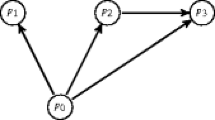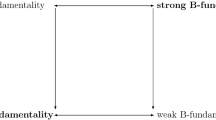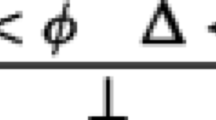Abstract
It is widely acknowledged that some truths or facts don’t have a minimal full ground [see e.g. Fine (Metaphysical grounding, Cambridge University Press, Cambridge, p 57, 2012a)]. Every full ground of them contains a smaller full ground. In this paper I’ll propose a minimality constraint on immediate grounding and I’ll show that it doesn’t fall prey to the arguments that tell against an unqualified minimality constraint. Furthermore, the assumption that all cases of grounding can be understood in terms of immediate grounding will be defended. This assumption guarantees that the proposed minimality constraint is significant for all cases of grounding. With its help one can get a clear grip on the relevance of grounding, a feature that will be put to use in the penultimate section.
Similar content being viewed by others
Notes
Audi (2012, p. 699). Audi takes grounding to be a relation between worldly facts and he neither acknowledges existential facts nor disjunctive or conjunctive facts. This makes his approach immune from the counterexamples to be presented. Most philosophers don’t want to restrict grounding in this way. The initial intuitive motivation brought forward by Audi is not dependent on his rather restrictive account of grounding.
For a discussion of the relation between the operator-view and its main competitor, the predicate-view, see Correia and Schnieder (2012). For ease of expression I will sometimes use “grounds” as a predicate (as in e.g. “That the ball is scarlet grounds that the ball is red”).
Cf. Fine (2012a, p. 51f) for the distinction between strict and weak ground.
This corresponds to what Fine calls “partial strict ground”. It should be mentioned that this, although it is the most intuitive notion of partial ground, is not Fine’s preferred notion of partial ground. He prefers “strict partial” ground, a notion of partial ground defined in terms of weak full grounding [see Fine (2012b p.4) for details].
The standard assumption is that partial strict ground is irreflexive. Nothing in my argumentation in this paper hinges on whether partial strict grounding is irreflexive or not.
Fine (2012a, p. 50).
Fine (2012a, p. 51).
This idea can also be found in Litland (2017, §6), but is (for technical reasons) not further pursued there.
Clark (2018, p. 6. I) adjusted Clark’s notation to the one used in this paper.
See Clark (2018, p. 6). One might have doubts whether Clark’s definition of dense grounding is adequate to capture the core feature of dense grounding. It might be argued that for a case of dense grounding to deserve its name, it should involve an infinitely large set of sentences \(S^{\lbrace \rbrace }\) that (1) is such that every two members of it stand in a relation of partial ground and (2) is densely ordered by partial grounding (Using “\(\prec \)” as a symbol for partial grounding, \(S^{\lbrace \rbrace }\) is densely ordered by partial grounding iff \(\forall X_{1},X_{2}\in S^{\lbrace \rbrace } (X_{1}\prec X_{2}\Rightarrow \exists X_{3}\in S^{\lbrace \rbrace } (X_{1}\prec X_{3}\prec X_{2})))\)). Not all cases falling under Clark’s definition exhibit this feature. I’d like to point out that the example of a case of dense grounding discussed below clearly does so. I stick with Clark’s definition for the sake of its simplicity.
To make this more precise: \(C_{1}\) properly includes \(C_{2}\) iff every maximally specific way of being of \(C_{2}\) is a way of being of \(C_{1}\), but not every maximally specific way of being of \(C_{1}\) is a way of being of \(C_{2}\).
See Fine (2012a, p. 57).
“\(\Delta \setminus \Delta _{1}\)” should be read as denoting the subplurality of \(\Delta \) that has all sentences among \(\Delta \) except for those among \(\Delta _{1}\) among it.
Audi (2012, p. 699)
This is put forward as a counterexample against exact verification in truthmaker semantics being minimal in Fine (2006).
Fine (2012a, p. 57).
This rule also follows from the following more general rule:
$$ \frac{{\Delta _{1} < X_{1} \quad \Delta _{2} < X_{2} \quad \cdots \quad \Gamma ,X_{1} ,X_{2} , \cdots < Y}}{{\Delta _{1} ,\Delta _{2} ,\Gamma \cdots < Y}} $$This rule is the rule Cut(\(</</\Gamma \)) in Fine’s pure logic of strict full ground. Cf. Fine (2012b, p. 22).
I’d like to thank an anonymous referee for suggesting this potential counterexample.
See Krämer and Roski (2015) for discussion.
One might worry that it is difficult to arrive at a suitable class of basic operations for truth-functional grounding in a principled way. To see the worry, consider the following example that I owe to an anonymous referee of this journal. If the class contains only one of the operations of logical nand (the “not both”-operation) and logical nor (the “neither nor”-operation), then there seems to be some arbitrariness involved, for both operations are functionally complete and each of them is the dual of the other. If the basic class contains both of the mentioned operations, then there is some redundancy in the basic class. But if redundancies cannot be avoided unless some arbitrariness is accepted, then the main reason for keeping the class of basic operation contained is undermined, so the worry goes. For the sake of argument I grant that making a choice between the two operations would be arbitrary and that making arbitrary choices ought to be avoided. I dispute that having to allow for some redundancies makes it impossible to keep the class of basic operations contained in a principled and motivated way. Take a redundancy-free candidate class and extend it by those redundant operations that are on par with the operations in the class with respect to naturalness and simplicity. A method like this gives you the result that having, say, logical nand in a class is a reason for also having its dual in the class. This avoids arbitrary choices. It doesn’t, however, motivate including each and every truth-functional operation one might come up with in the basic class.
This example plays a crucial role in one of Jonathan Schaffer’s alleged counterexamples against the transitivity of (non-contrastive) grounding. It will be revisited below. See Schaffer (2012).
There’s a second reason to believe that \(p_{1},p_{2},p_{3},\ldots \) is not an immediate ground of there being infinitely many numbers. Clearly, \(p_{1},p_{2},p_{3},\ldots \) grounds that there are \({\mathbb {N}}\)-many natural numbers, i.e. as many natural numbers as there are in the set of all natural numbers. In opposition to this, \(p_{2},p_{3},p_{4}\ldots \) grounds that there are \({\mathbb {N}} \setminus \lbrace 1 \rbrace \)-many natural numbers. If these were distinct specific ways for there being infinitely many natural numbers, then the above considerations would suggest that the grounding has to be seen as mediated by them. In this case, \(p_{2},p_{3},p_{4}\ldots \) would also be a minimal full ground of there being \({\mathbb {N}} \setminus \lbrace 1 \rbrace \)-many natural numbers, for if \(p_{n}\) (for any \(n>1\)) where taken out of the ground, the ground would become a ground of there being \({\mathbb {N}} \setminus \lbrace 1,n \rbrace \)-many natural numbers which, by analogous reasoning, would be yet another way of there being infinitely many natural numbers. There is growing interest in what are called Euclidean theories of measuring the sizes of sets, theories that obey the principle that the size of every set is larger than the size of any of its subsets [see e.g. Benci et al. (2007), Benci and Nasso (2003), Parker (2009)]. Insistence on this principle is not only present in the recent literature, but can also be found in the writing of Bolzano (2012). Every Euclidean theory of set-sizes has it that the size of \({\mathbb {N}} \setminus \lbrace 1 \rbrace \) is smaller than the size of \({\mathbb {N}}\), for the former is a proper subset of the latter.
Gettier (1963).
See Williamson (2000) for a prominent endorsement of this position.
In presenting the alleged counterexample I take into account the refinements proposed in Litland (2013, p. 21f) (see esp. fn. 11).
Schaffer (2012, p. 127). Italics in the original.
See Litland (2013, p. 23).
Litland also uses these two locutions, the talk about ways to be the case and how something is the case, to elucidate the same underlying idea. See Litland (2013, p. 23).
See Litland (2013, p. 24).
See Fine (2012b, p. 7ff).
See Fine (2006).
Spelling out the way in which supervenience is monotonic is a bit more difficult, for supervenience is an umbrella term for a variety of relations, mostly relations between classes of properties. For discussion and an overview cf. Leuenberger (2008).
References
Audi, P. (2012). Grounding: Toward a theory of the in-virtue-of relation. Journal of Philosophy, 109(12), 685–711.
Benci, V., & Di Nasso, M. (2003). Numerosities of labelled sets: A new way of counting. Advances in Mathematics, 173(1), 50–67.
Benci, V., Nasso, M., & Forti, M. (2007). An Euclidean measure of size for mathematical universes. Logique Et Analyse, 50, 43–62.
Bolzano, B. (2012). Paradoxien des Unendlichen. Hamburg: Felix Meiner Verlag.
Clark, M. J. (2018). What grounds what grounds what. The Philosophical Quarterly, 68, 38–59.
Correia, F. (2010). Grounding and truth-functions. Logique Et Analyse, 53, 251–279.
Correia, F., & Schnieder, B. (2012). Grounding: An opinionated introduction. In F. Correia & B. Schnieder (Eds.), Metaphysical grounding: Understanding the structure of reality (p. 1). Cambridge: Cambridge University Press.
deRosset, L. (2015). Better semantics for the pure logic of ground. Analytic Philosophy, 56(3), 229–252.
Dixon, T. S. (2016). Grounding and supplementation. Erkenntnis, 81(2), 375–389.
Fine, K. (2017). Truthmaker semantics. In B. Hale & C. Wright (Eds.), A companion to the philosophy of language. New York: Blackwell.
Fine, K. (2012a). Guide to ground. In F. Correia & B. Schnieder (Eds.), Metaphysical grounding (pp. 37–80). Cambridge: Cambridge University Press.
Fine, K. (2012b). The pure logic of ground. Review of Symbolic Logic, 5(1), 1–25.
Gettier, E. (1963). Is justified true belief knowledge? Analysis, 23(6), 121–123.
Krämer, S., & Roski, S. (2015). A note on the logic of worldly ground. Thought: A. Journal of Philosophy, 4, 59–68.
Leuenberger, S. (2008). Ceteris absentibus physicalism. In D. W. Zimmerman (Ed.), Oxford Studies in Metaphysics (pp. 4–145). Oxford: Oxford University Press.
Litland, J. E. (2013). On some counterexamples to the transitivity of grounding. Essays in Philosophy, 14(1), 3.
Litland, J. E. (2017). Grounding ground. Oxford Studies in Metaphysics, 10, 279–316.
Parker, M. W. (2009). Philosophical method and Galileo’s paradox of infinity. In B. Van Kerkhove (Ed.), New perspectives on mathematical practices: Essays in philosophy and history of mathematics. Brussels: World Scientfic.
Schaffer, J. (2012). Grounding, transitivity, and contrastivity. In F. Correia & B. Schnieder (Eds.), Grounding and explanation. Cambridge: Cambridge University Press.
Schnieder, B. (2011). A logic for ‘because’. Review of Symbolic Logic, 4(3), 445–465.
Williamson, T. (2000). Knowledge and its limits. Oxford: Oxford University Press.
Acknowledgements
I wish to thank all members of the phlox-research-colloquium, the audience at the first Glasgow meets Hamburg-workshop as well as Fabrice Correia, Stephan Krämer, Roberto Loss and Stefan Roski for very helpful discussions about earlier versions of this paper. Furthermore, I would like to thank two anonymous referees of this journal for their very helpful comments.
Author information
Authors and Affiliations
Corresponding author
Rights and permissions
About this article
Cite this article
Werner, J. A Minimality Constraint on Grounding. Erkenn 85, 1153–1168 (2020). https://doi.org/10.1007/s10670-018-0071-z
Received:
Accepted:
Published:
Issue Date:
DOI: https://doi.org/10.1007/s10670-018-0071-z




